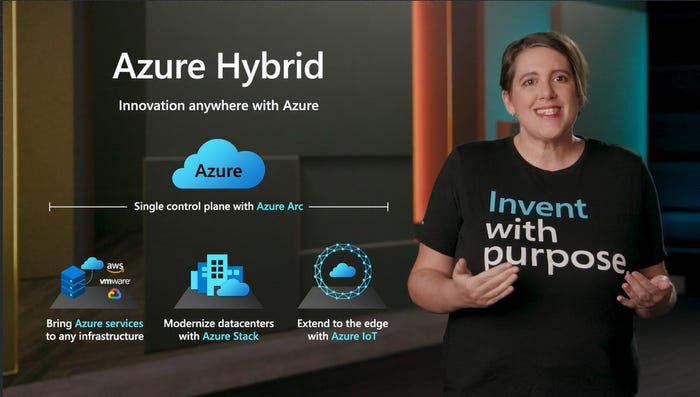Microsoft Widens Hybrid Cloud Path with New Azure Arc, Azure Stack Hub ReleasesMicrosoft Widens Hybrid Cloud Path with New Azure Arc, Azure Stack Hub Releases
At Microsoft Ignite this week, the company added new hybrid cloud services.
September 25, 2020

MICROSOFT IGNITE — Microsoft this week advanced its hybrid cloud portfolio with the general availability of Azure Arc-enabled servers. The release, announced during this week’s Microsoft Ignite virtual conference, enables management of on-premises servers from the Azure Portal.
Azure Arc is the evolution of Azure Stack, appliances that let cloud service providers and customers run Azure cloud instances. Microsoft released Azure Stack in 2017 as turnkey systems co-engineered with OEMs including Cisco, DellEMC, HPE, Lenovo and others.
Microsoft introduced Azure Arc as a software-only alternative to Azure Stack, which until now was only available as hardware-based appliances. Unveiled at last year’s Ignite conference, Arc lets Microsoft’s broader ecosystem offer point hybrid cloud solutions. Partners and customers can deploy Azure Arc on their own hardware.
The Azure Resource Manager and portal provides unified management of Azure Arc, Azure Stack and the Azure public cloud.

Microsoft’s Erin Chapple at Ignite Virtual 2020
“With Azure Arc, you have a single control plane to consistently manage and govern all of your IT resources wherever they reside,” said Erin Chapple, a Microsoft corporate VP for Azure compute, during an Ignite presentation.
The release of Azure Arc-enabled servers lets customers and partners “seamlessly manage, govern and secure Windows and Linux servers, whether these are on-premises, in public clouds or at the edge, all from a single place — the Azure portal,” Chapple added.
Azure Arc provides management of physical servers and virtual machines.
Big Plans for Azure Arc
Microsoft’s plans for Azure Arc extend beyond adding physical servers and VMs. The Azure Arc road map includes Arc data services and Arc-enabled Kubernetes. At this week’s Ignite, Microsoft released technical previews of both.
The first Azure Arc data service previews include Azure SQL Managed Instance and Azure Postgre SQL Hyperscale. Both “are the first set of Azure Arc enabled data services that can be deployed to on premises, multicloud and edge environments, with support for both connected and disconnected modes to maximize consistency and flexibility,” Chapple said.
Service providers can use Azure Arc with Microsoft’s partner management tool, Azure Lighthouse, to provide cloud-managed services. Among those Microsoft showcased at Ignite include Avanade, Fujitsu, KPMG Japan and Siemens Healthineers.
Expanding Azure Stack
As part of Microsoft’s introduction of Azure Arc last year, the company also fleshed out Azure Stack. New variations include Azure Stack HCI and Azure Stack Hub. Microsoft added Azure Stack Hub for edge locations that can also run when disconnected from the internet and from Azure.
Like Azure Stack, Microsoft’s hardware partners also offer Azure Stack Hub as appliances, configured in racks of 4-16 servers. At this week’s Ignite, Microsoft announced the general availability of Azure Stack Hub with GPUs. Options include AMD’s Mi25 GPU and NVIDIA’s V100 Tensor Core GPU.
The latter is designed to run major machine learning and visualization workloads when disconnected. For lighter machining and visualization workloads, versions of Azure Hub will come with NVIDIA’s T4 Tensor Core GPU.
Meanwhile, Azure Stack HCI, which is in preview, is based on a new hyperconverged infrastructure operating system. It can run Windows or Linux VMs and can offer on-premises instances of Azure Backup, Azure Monitor and Azure Security Center.
The latest option announced this week, Azure Kubernetes Service (AKS) on Azure Stack HCI, is now available in technical preview.

Microsoft’s Julia White
“This provides a consistent, secure and fully managed Kubernetes experience for customers who want to use Azure Stack within their data centers,” said Julia White, corporate VP for Microsoft Azure, during an Ignite presentation.
New Azure Services Available
Microsoft announced that its Azure VMware Solution is now generally available. The solution, certified by VMware, allows migration of vSphere VMs to Azure. Besides vSphere, Microsoft said the new Azure service includes the most current VMware Cloud Foundation components including, NSX-T, HCX and vSan.
The Azure VMware Solution is available with Microsoft’s Azure Hybrid Benefit license option. According to Chapple, VMware workloads represent among the most common migration scenarios. Chapple said the Azure VMware Solution “fully integrates on premises environments with Azure, so you can embrace the cloud at your own pace and utilize your existing tools and skills.”
Microsoft also announced the general availability of Azure SQL Edge, a SQL data engine for small footprint IoT gateways and edge devices. Azure SQL Edge is built on Microsoft’s SQL Server and Azure SQL codebase but designed to run x64 and ARM 64-based edge hardware.
Azure SQL Edge removes the latency of streaming data to the cloud, by processing it at the source. According to Microsoft, Azure SQL Edge can analyze relational SQL data as well as time series JSON and graph data.
About the Author
You May Also Like


